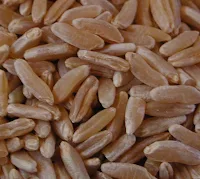Kamut
The wheat was first cultivated about 9,000 years ago in today's Irak. For some reason, probably by chance, there was a hybridization in a plant grass that grew wild. Such hybridization caused on the ground that the grains were larger and the flour could be obtained from it also became larger, so it was profitable for the local economies. At that time also start the introduction of livestock in local economies which would allow a contribution of protein that so far could only be obtained from the hunt. The success was so great that populations grew significantly and the pair agriculture and livestock was extended by Middle East in a relatively short time. It happened that the great civilizations of Mesopotamos, settled in its agricultural wealth, developed further with large irrigation works and pipes carrying water from the Tigris and Euphrates over long distances. Unfortunately, the irrigation water carries certain amounts of salts that are deposited on the floor and finish by its salinization. For this reason, a few thousand years later it became difficult in Mesopotamia cultivating wheat as it supports bad salt in the soil, so the most tolerant barley cereal that became predominant. Egypt became the largest producer of wheat World's old and remained until relatively recent times. In fact the word in turkish names to Egypt at present is still "Misir" which literally means "corn".
The wheat we consume at present has little to do with the wheat consumed by the ancient Egyptians. Already at the time was hybridization of semi-natural way to get large numbers of different varieties. The former did not know the mechanism of selection but perceived that certain species were more suitable for some types of terrain and climate and without knowing exactly what was happening they started to selecte varieties. Perhaps they grew simultaneously two or three varieties of wheat because their qualities and eventually obtained, since the species were related, a single variety bringing together the best of the three. These hybridzations naturally occurring over thousands of years. It is a situation not unlike the use of genetics is being done now. With genetics we get species with enhanced features in a given period of time rather small but not "suffer" a process of selection by Nature. And therein lies one of its dangers. Nobody is quite sure about what happens when a DNA laboratory is hybridization with natural DNAs and even how the new species will behave in the long run. The so-called kamut wheat is a natural wheat whose owners - in fact, have owners so that should write "kamut (r)" as a trademark - argue comes from ancient Egypt. The beautiful story is that the original grains were found in a tomb of Dashare. These grains came to the United States and came after an eventful experience to grow demonstrating his great qualities and even in 1990 the U.S. agriculture department recognized kamut as protected variety called technically as QK-77. With this subtle novel story they come to say that this is wheat "original" as there are 4000 years of the current wheat, a lifetime of hybridizations, simply do not exist for kamut. Wheat is "pure". The story, no matter how beautiful it sounds - a plant of the past returning to present - can not be true. The main reason is that the wheat grain is not able to endure thousands of years without deteriorating. It is true that some seeds of the past have been able to germinate in the present, but its structure was significantly different from that of wheat. Most likely, the kamut (r) comes from existing plants and is almost certain that this is a hybridization between the species, durum and triticum polonicum, two species easily found on Egyptian soil at the moment and certainly nothing exotic (but it is true that much less hybridizing). To doubt about this theory is also damaging to one's own name kamut, because it is a word that would mean Egyptian wheat or grain. The word kamut was elected as a trademark, not as scientific name of the plant, mainly because it is a word from one language into disuse already extinct: there were no complaints of any kind (unless Ramses was lifted from the grave, and still can not say anything because he never saw such grain in life). In the seventh century Egyptians changed their original language in Arabic and that only preserves, significantly altered, in the Coptic liturgy. As curiosity is true that our language retains a word of ancient Egyptian and this gave them that Ramses similarly: oases. Not needed so big fable to invent a product that by itself is already very interesting. Kamut has a fairly larger grain than the usual grain which in itself makes it very attractive economically. On the other hand has far less water than similar grains which makes it less easy it rots and more resistant to attacks by insects. This is very important because if anti-insects means that we can grow with fewer or no pesticides and this makes the kamut is ideal for organic farming. Nutritionally speaking provides a greater contribution of complex carbohydrates that the conventional wheat. Almost 70% are amino acids, being lysine the most important. The contribution of minerals is also much higher but mainly provides plenty of vitamin E, about 30% over conventional grains. Despite that allergic to gluten appear to show much less rejection of the grain kamut it still contains gluten so that its intake is still discouraged, at least for more severe allergies. The grain kamut has less fiber than the grain of conventional wheat. Because of its qualities and the fact preferably organic farming as we have seen is that we can find in stores kamut dietetics, naturalists or vegetarian. Usually comes in a holistic manner but it is also possible to find in any format, from flour, pasta, bread (in fact now is not so strange spelt bread, another variety of wheat very healthy) until the grains to make inflated breakfast cereal. As long as we deal with these products that have already been aligned in the side of food or vegetarian diet (such as tofu, wheat gluten, algae etc.) we should not stop taking them, whatever our usual diet. A good way would take a muesli with kamut every morning, for example. As we have seen the kamut is a registered trademark in the United States and is considered a protected variety. The United States is the main producer in the world while other countries such as Argentina and Australia also produce it in significant quantities. It is worth noting that this is not a variety or transgenic genetically treated. Nothing about that. In fact the kamut would be the antithesis of a transgenic. For a product can be considered kamut is necessary to comply with some parameters that can be found on the official website http://www.kamut.com/ Among other qualities must contain between 400 and 1000 ppm (parts per million) of selenium, between 12 and 18% of protein, be free in 99% of hybridizations with modern varieties of wheat.
The kamut is a good and healthy option of taking wheat nearly identical to what our ancestors took, although not the same as taking the ancient Egyptians.




Comments
1. The tomb in Dashare is a story the young man from Fort Benton, MT heard when he received the grains around WWII. We now know that it didn't survive in a tomb (that is scientifically been proven), but that he was not told the truth about where his friend got it.
2. We have done numerous genetic testings and Kamut grain and durum wheat both stem from the same ancestor, emmer. Khorasan (the scientific name for Kamut)is not however, a cross between durum and Triticum poloncum (polish wheat). It was mis-classified as Polish wheat years ago when not much was known about Kamut because it wasn't in commercial use anywhere. It probably survived over the centuries by native subsistance farming systems.
3. Bob Quinn (who also has a PhD in plant biology) traveled to Egypt to test the theory that the grain came from there. He found Kamut grain growing on small family plots in Egypt. However, Kamut grain actually yields much lower than most wheats so therefore it had not been commercially grown, until Bob Quinn drummed up interest. It didn't make economic sense. Kamut probably grew better in Egypt before the Nile river was damed up. It is a dryland crop and doesn't respond well to a lot of water (irrigation). So it was in Egypt but could probably be found all over the Fertile Crescent region where wheat originated (Turkey, northern Africa, Asia minor, Middle East etc)
4. The vast majority of Kamut brand grain grows in Canada (southern Alberta and Saskatchwan), with some in the USA as well. We have been trying to grow in Australia and Turkey, but drought conditions have not been favorable for us there in several years. As far as Argentina, we did trials there years ago but the quality was not good, there were economy troubles and we have not worked with them since 2002.
5. Finally, Bob trademarked the name Kamut, so he could guarantee that it was always organically grown and in it's original version that came to Montana in the 1940's. We also test every field kamut is grown on, so we know all the parameters for a healthy crop. He doesnt want to "own" a grain just be able to guarantee certain qualities of all Kamut brand products.
I felt the need to clear up some misunderstandings so our company can be represented fairly. Should you have any more comments or questions please contact us. We love to hear from folks and have an open-door policy!
Thanks,
Tara Blyth
www.kamut.com